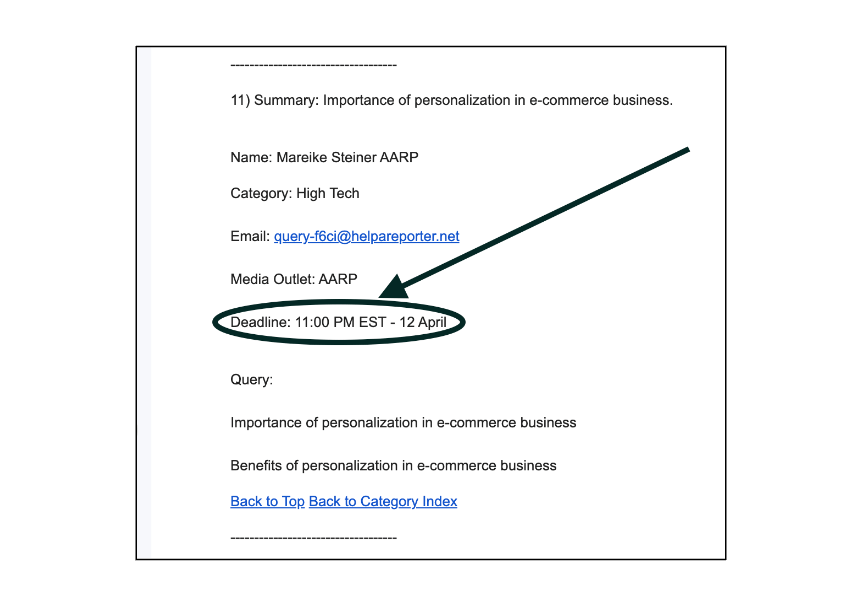- What Is HARO?
- How to Write a Successful Pitch
- Be Selective
- Respond Quickly
- Or, Wait to Respond Until Right Before the Deadline
- Put "HARO:” at the Beginning of Your Subject Line
- Personalized Greeting
- … then Jump Right In
- 300+ Words
- Make It Quotable
- Include Something Unique
- Formatting
- Add a Conclusion
- Double-Check Your Info
- Track Your Results
Table of Contents
Help a Reporter Out (HARO) is a powerful tool for building backlinks.
Not just any backlinks, either — high-quality ones. Links from sites that can be very difficult to get links from otherwise.
But HARO is competitive. After all, the Cision-owned platform has over one million users. I actually put out a HARO call for quotes to use in this article (you can read some below), and I got 75 responses in just a few hours. That’s some heavy competition!
So how do you make your pitches stand out? How do you increase your chances of landing a quote and earning a backlink?
Read on for some helpful tips.
What Is HARO?
If you’re here because you’ve heard about HARO but still don’t understand what it is, let me explain:
Help A Reporter Out is a digital PR platform that connects journalists and bloggers with expert sources.
These writers submit “query” listings through helpareporter.com, and those listings are distributed widely through HARO’s daily emails.
Each newsletter contains dozens of queries related to different topics. Over 1 million people receive the newsletter every day. Recipients can browse the email, choose the topics they want to respond to, and send their pitches directly to the author.
The author then reviews the pitches and chooses the ones to quote in their article.
Small business owners and marketers love HARO because it’s a great tool for link building and public relations. Bloggers and journalists love it because it gives them easy access to expert contributors.
Is HARO Free?
Yes, and this is one of the reasons why the platform is so popular.
HARO has a few tiered pricing options that come with certain benefits, but a free subscription gives you access to the full newsletter.
How to Write a Successful HARO Pitch
Before we walk through them individually, here’s our full list of tips to keep in mind as you’re pitching:
- Be selective about which queries you respond to
- Respond quickly (as fast as you can after the query is posted)
- …or wait to respond until right before the deadline
- Put “HARO:” at the beginning of your subject line
- Start with a personalized greeting
- …then jump right into your response
- Aim for 300+ words
- Make it quotable
- Include something unique
- Tweak the formatting with highlights, italics, etc.
- End with a brief conclusion
- Double-check your contact info
- Track your results
Keep reading for an explanation of each of these tips.
1. Be Selective About the Queries You Respond To
Not every query is worth responding to. You’ll see a higher success rate if you focus on the queries that are most relevant to you.
You should only respond to a listing if you can weigh in with valuable insight that’s informed by real-life experience. Don’t respond to a query if you have to Google the answer — it will take you too much time, and you probably won’t get a link. Remember, you’re competing against experts.
As Maria Harutyunyan, Head of SEO and a co-founder at Loopex Digital, says, “If I’m not the right person to answer their question, I won’t waste their time with some vague response.”
Lucia Tang, Head of Content at Keeper, seconds this: “My secret to succeeding on [HARO and similar platforms] is staying in my lane. My team and I won’t waste time responding to queries if we don’t have relevant experience or credentials.”
2. Respond Quickly
When you sign up for the newsletter on helpareporter.com, you’ll receive three daily HARO emails, each containing new questions. They’ll arrive in your mailbox at the following times:
- 5:35 A.M. EST
- 12:35 P.M. EST
- 5:35 P.M. EST
The faster you can respond to a query after it has arrived in your mailbox, the better your chances of getting quoted.
Why?
Well, as SEO Consultant Dustin Montgomery points out, the author may not wait until the deadline to start pulling quotes. “You want to be available whenever they start writing,” Dustin says.
Also, when a journalist or blogger publishes a HARO request, they get dozens, if not hundreds of pitches. They may not have time to even open them all, let alone read them. If they start with the first pitch they received, you’ll have a better chance of them seeing your pitch.
3. Or, Wait to Respond Until Right Before the Deadline
Of course, being the first responder is only valuable if the writer opens their emails in the order they received them. There is always a chance that the writer will open the most recent one first and work down their inbox.
In that case, it would benefit you to be the last person to respond.
Every writer sets a deadline for responses when they submit their call to HARO. That deadline is visible in the call listing when you view it in the newsletter (as seen below). HARO will reject your query if you submit your response even just a few seconds after the deadline, so make sure not to miss it, or the writer won’t even receive your email.
Author’s Note: The point here is that you don’t want your response to end up in the middle of the writer’s inbox, where it’s the least likely to get opened. Closer to the posting time has the highest success rate for us, but just under the deadline is the next best option.
4. Put “HARO:” at the Beginning of Your Subject Line
Leading your subject line with “HARO” will make it easy for the writer to recognize that your email is a response to their listing. All responses are sent directly to their inbox, so this can help to differentiate your email from all of the non-HARO emails around it.
The full subject line should include the listing’s title (or some version of it that contains its key terms). For example, if you’re responding to a listing titled: “Seekings Experts to Discuss the Most Effective Digital Marketing Techniques in 2024,” your response might come with the subject line: “HARO: 2024 Digital Marketing Techniques.”
If you lead with “2024 Digital Marketing Techniques” and fail to include the “HARO” part, they might mistake your response for an email newsletter.
5. Start With a Personalized Greeting
Addressing the author by name is an easy way to let them know that your response isn’t rushed. They won’t always include their name in the listing but you should use it if they do.
From a writer’s perspective, one of the worst things about HARO is the number of AI-generated and cut-and-paste template responses that flood your inbox as soon as your listing goes live. Some of the responses are so bare and off-topic that you wonder whether the responder actually read your query.
Manual link building is a numbers game in many ways, so it makes sense to fire off responses as fast as you can, but taking an extra second to include the author’s name shows them you actually put time and effort into your pitch.
6. … then Jump Right Into Your Response
Most HARO listings ask you to list your name, job title, and website in your email, but only sometimes do they tell you where to include it.
Here’s my advice on that:
Unless the author specifically asks you to include your personal info at the top of the email, put your name, job title, and website at the bottom.
Why?
Because it will encourage the reader to actually read your response before your job title or website become factors in their decision.
For example, maybe the writer wants to quote content marketing agency owners but didn’t specifically ask for that in their listing. If you’re a freelance writer or a content strategist working for an agency, you could be ruled out just because you’re not the owner they’re looking for — despite having a great answer.
Likewise, writers might ignore your pitch because they’re biased toward high-authority domains.
When I’m working to build links for a new website, I find that I have a lower success rate when I lead the email with the author’s contact info. My success rate goes up when I move that info to the bottom (after a thorough response, of course).
7. Aim for 300+ Words
In my experience, pitches longer than 300 words perform better than shorter ones. Pitches under 100 words have a very low success rate (except in cases where the author had a word limit).
Why is this the case?
My theory is that longer responses give the writer more content to pull from. If you only send them two sentences, you’re betting that they’ll actually want to use those two sentences.
Yes, you can submit more queries if they’re shorter. However, you’re likely to see fewer backlinks with that approach
If you spend fifteen minutes crafting one well-considered response (instead of just churning out three short ones), you’re likely to see a higher ROI on your time.
8. Make It Quotable
Again, writers are looking for quotes here. They might be writing with a word limit, too, so be conscious of that and give them something that will fit neatly into an article. Any sentence over 30 words is likely too long.
Dawid Zimny adds that readability is an important factor in this regard. “I aim for a Flesch Reading Ease score of at least 60 for each response,” says the NerdCow product manager. “It’s all about the user experience for the readers, but I suspect it makes the job easier for the journalists as well.”
9. Include Something Unique
If possible, include something in your response that no one else could write.
A personal anecdote. A link to a case study. Some snippets of your own data. Anything that highlights your unique expertise will boost your chances of getting quoted.
Keep in mind that the person you’re writing to is a writer themselves, and they’re trying to build a story that’s entertaining and informative for their audience. If you can help them accomplish that, they’ll want to include you.
As Eric Doty, Content Lead at Dock, says: “Writers want insights and expertise they can’t find through their own research (i.e., Googling). The best way to give them that is to provide real, specific examples or anecdotes from your own experience rather than vague, high-level advice.”
10. Tweak the Formatting
Make your emails more engaging by adding a few visual elements and playing around with the formatting. For example, you might underline or highlight your key points to direct the reader’s attention to that section.
If you have any email marketing experts on your team, ask them for some tips on how to design a visually engaging template for your HARO responses. Even just a few adjustments to your font size, color, and layout can help your emails stand out from the pile.
Fernando Lopez, Marketing Director at Circuit, recommends bolding 1-2 sentences to make it easier for your recipient to grab key points from your pitch. “You want to make your email ‘skimmable,’” he says. “If the journalist likes your bolded points, they’ll be compelled to read more.”
Just make sure not to overdo it, though. Using too many colors can get your emails flagged as spam, and your recipient may never see them.
11. End With a Brief Conclusion
By the time they get to the end of your email, the reader will likely have already decided whether or not they’re going to quote you. You don’t need to waste time writing a lengthy conclusion, as they probably won’t read it.
However, you should let your reader know that you’re open to follow-up questions if they have any. Many journalists have a source database they use for writing, so let them know you’re open to responding to future queries, as well.
12. Double-Check Your Personal Info
We talked about the importance of placing your contact info at the bottom of your response (so that the writer reads it before they consider your job/company/website).
But here’s a related tip:
Make sure to include every piece of personal info that the listing asks for.
Some listings just ask for your name, job title, and company website. Others want a 75-word biography, your LinkedIn URL, or a headshot.
There are two reasons why writers ask for these things:
- To rule out the responses that don’t include them
- Because they can’t write the article without them
So, before you hit send, reread the listing and make sure you’ve included everything. You’ll increase your chances of getting quoted by responding in their requested format.
13. Track Your Results
Tracking your performance can help you get better at anything. I recommend keeping a spreadsheet with data about your pitches so you can see the similarities shared by your successful ones.
At Intergrowth, we track key points related to all of our HARO pitches:
- Response date
- Publisher site
- Publisher site domain authority score
- Response word count
- Day and time response was sent
- Time query listing was posted
- Formatting decisions
Our goal in tracking these data points is to be able to pinpoint what makes a successful pitch. Once you see that a certain format (or a certain time period) works better than others, you can repeat that format to increase your success rate.
Jon Davis at OnPay takes this a step further and saves all of his responses in a “master document” so he can reference them later. This is a particularly useful step for marketers who respond to HARO queries on behalf of a non-marketer and may not be experts in the field they’re writing about.
“That way, we can easily find the topics we’ve responded to in the past and make sure we are truly pitching original ideas that a writer can use,” he says.
Final Points
When it comes to HARO responses, here’s the most important advice I can offer:
Make sure to read the listing carefully. Respond directly to the questions asked. Include all of the information they ask for, too, because many writers will dismiss your email if it doesn’t.
Also, remember that HARO isn’t the only link-building tool out there on the internet. There are a number of HARO alternatives (Help A B2B Writer, Qwoted, Terkel, etc.), and there are a ton of other strategies you can use to build links from media outlets.
If you want to take your link building strategy to the next level, we could be the perfect partner for you. We love helping people to build links and rank higher in Google, so get in touch with us today, and we’ll schedule a call to learn more about your goals.
SCALE YOUR ORGANIC TRAFFIC
Subscribe to our monthly newsletter





